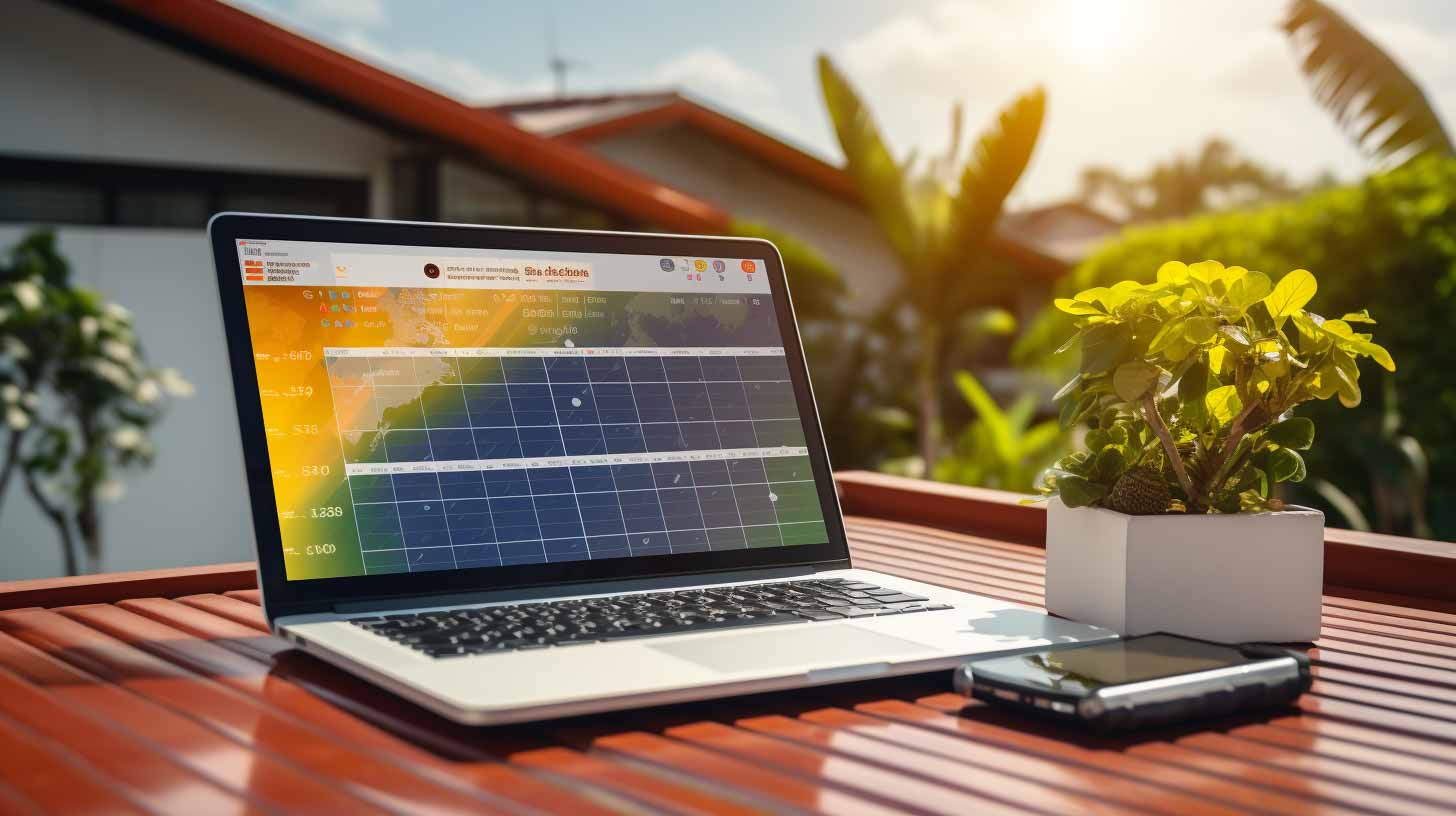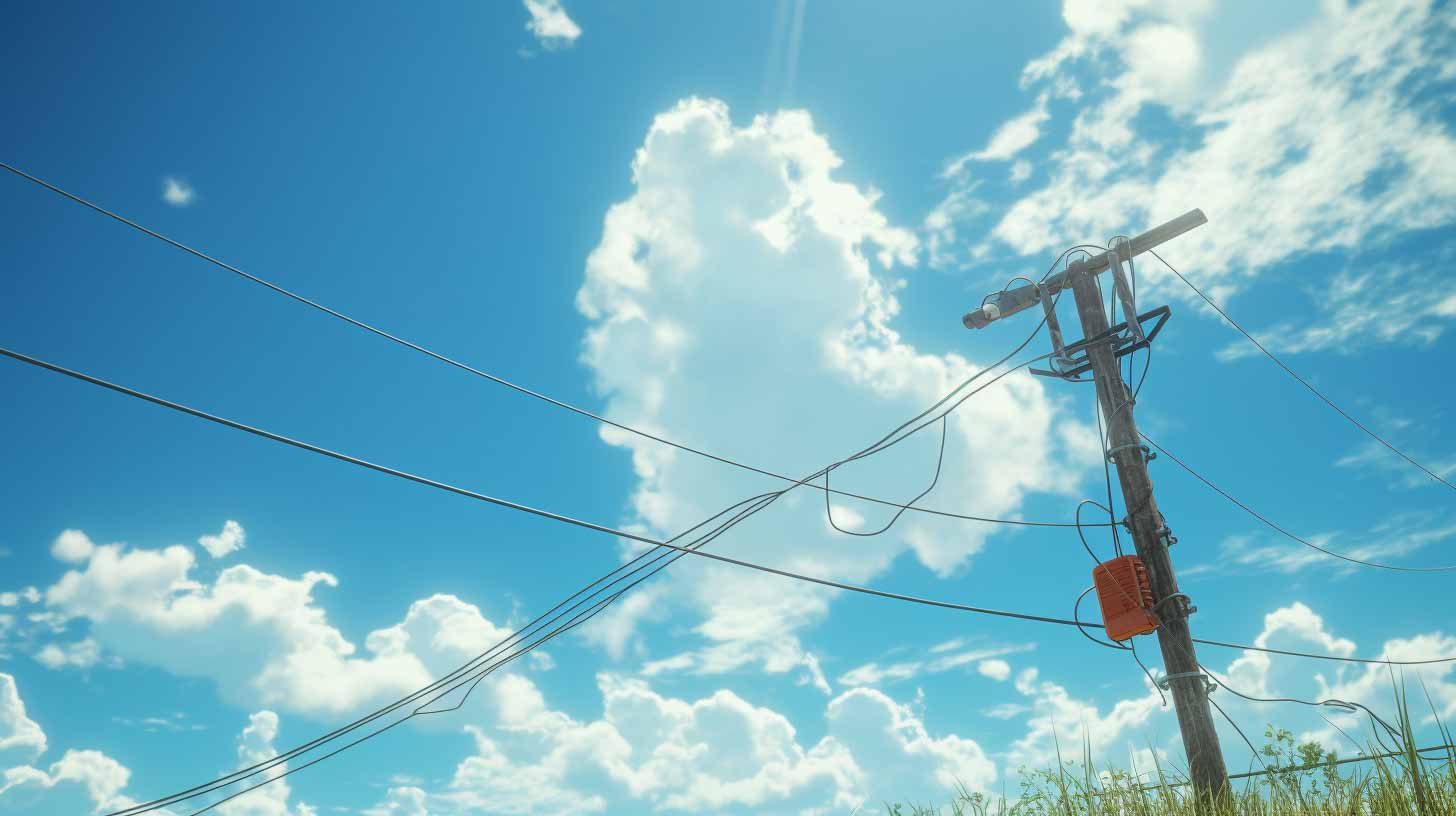You’ve heard about the buzz, haven’t you? Solar is paving the path for a greener future. It’s 2024, and there’s never been a better time to understand how solar energy can revolutionise your life and finances. Now more than ever, making informed decisions about energy use is essential. From understanding what ‘PV’ means in the solar world or deciphering government rebates to knowing how electricity is generated from those shiny panels on your roof – we’ve got you covered.
In this insightful guide, we’ll delve into everything you need to know about solar this year using clear-cut language and keeping jargon at bay. We’ll even help you navigate through finding the best installer for your home because getting started should be as straightforward as possible. So buckle up; let’s illuminate this path together!
Key Takeaways
- Solar energy is a renewable and sustainable method of generating electricity from the sun’s energy.
- Solar panels, inverters, and batteries comprise a typical home solar system.
- Solar energy offers both environmental and financial benefits, including reduced carbon footprint and savings on electricity bills.
- It is vital to have knowledge and research before investing in solar, including understanding how solar panels work and choosing a reputable company for installation and maintenance.
What is solar?

You might be wondering, ‘What exactly is solar?’ Well, it’s a method of generating electricity from the sun’s energy. This renewable and clean resource can help you gain control over your power bills and contribute to sustainable living. When we say “solar,” we’re referring specifically to solar electricity produced by harnessing sunlight with the help of specific technology – most commonly, solar panels.
Solar panels are devices designed to absorb sunlight and convert it into usable electricity. They’re made up of numerous photovoltaic (PV) cells that work together to generate electric current when exposed to light. But don’t worry about getting lost in technicalities; the main takeaway is that these panels can convert freely available sunshine into energy you can use at home or in your business.
So why does this matter in 2024? It’s simple: harnessing solar energy is more relevant than ever for two main reasons. First off, the cost of traditional, non-renewable energy sources continues to rise. With solar, however, once you’ve covered the initial setup costs – which have been decreasing significantly over recent years – your ongoing expenses will be minimal. Secondly, using solar power contributes positively towards reducing our carbon footprint and combating climate change – an issue that cannot be ignored any longer.
The beauty of understanding what solar is lies not just in its financial benefits but also in its environmental impact. Going solar means investing in a future where you are less dependent on external factors for your energy needs while actively contributing towards a greener planet.
How is solar electricity generated?

Harnessing the sun’s energy, solar panels convert this abundant natural resource into electricity via the photovoltaic effect, where sunlight hitting the silicon cells in the panel generates an electric current. If you’ve been wondering how solar panels are made, they’re composed of many small units known as photovoltaic cells. Each cell is like a sandwich of two slices of semi-conducting material, usually silicon — just like what’s used in microelectronics.
When light shines on the cell, it creates an electric field across its layers and voila! You have electricity. The electricity is then fed into a device called a solar inverter that transforms it from DC (Direct Current) to AC (Alternating Current), the type of power that you use when you plug something into your home wall socket.
Now, let’s talk about production capacity. The kilowatts a solar system can produce depends on factors such as panel efficiency and size, orientation towards the sun and location specifics like climate and weather patterns. Generally speaking, though, an average home installation might range between 5kW to 10kW, depending on these factors.
Solar technology has come leaps and bounds over recent years, offering higher efficiencies at lower costs and making it more accessible. It’s our prediction for 2024 that with continuous advancements in technology, we’ll be seeing even more efficient systems that reduce and potentially eliminate your electricity bills!
Remember, our team is here to guide you through this journey – with Lamora Energy, gaining control over your energy production doesn’t need to feel complicated or intimidating. Together, we can help you step confidently into your energy future. Contact us today if you’re thinking about getting solar.
Solar Terminology

Let’s unpack some of that solar jargon, making it easy to understand! When you’re considering solar installation, there are several key terms you’ll come across. Don’t let them intimidate you – we’re here to help.
Photovoltaic (PV):
This is the scientific term for converting light into electricity. The best solar panels use photovoltaic cells made from silicon and other materials.
Solar Inverter:
Once your PV cells have captured sunlight and turned it into Direct Current (DC) electricity, an inverter is needed to convert this DC power into Alternating Current (AC). AC is what your home appliances use.
Net Metering:
This billing arrangement allows you to return excess energy to the grid for credits on your power bill. It’s like being paid for creating clean energy!
Solar Panel Efficiency:
This refers to how well your solar panels convert sunlight into electricity. Higher efficiency means more bang for your buck regarding solar panel cost.
Solar Array
A collection of solar panels or modules arranged in a specific pattern to capture sunlight and generate electricity.
Solar Insolation
The amount of solar radiation or sunlight that reaches a specific area over a given period. It is often measured in peak sun hours and is used to determine the potential solar energy production at a location.
Solar Rebate
Governments or utilities provide financial incentives to encourage the adoption of solar energy systems. These rebates can offset the initial cost of installing solar panels.
Solar Panel Mounting Systems
These are the structures or frameworks that hold solar panels in place. There are various types, including roof-mounted, ground-mounted, and tracking systems, each designed to optimize the panel’s exposure to sunlight.
Solar Energy Storage
Refers to using batteries or energy storage systems to store excess electricity generated by solar panels during the day for use during periods of low sunlight, such as nighttime or cloudy days.
As 2024 unfolds, advancements in technology are driving down the costs while increasing the efficiency of solar panels. We’re seeing a future where every Australian home harnesses the sun’s power efficiently and effectively, a future where high electricity bills become distant memories.
Remember, our team at Lamora Energy endeavours not just to offer you solutions but also to empower you with knowledge and confidence as we steer towards this sustainable future together. So next time someone tries baffling you with complex terminology related to green energy, stand tall, knowing that owning your energy freedom is simpler than ever!
Related articles
What does PV mean in solar – An in-depth explanation
Lamora’s 2024 Guide To Home Solar & Electric Vehicles (EV)
What makes up a home solar system?

Imagine the thrill of owning your power source and the peace of mind that comes with understanding each component of your home solar system. A typical system comprises three main components: solar panels, an inverter, and a solar battery.
Your solar panels are like mini power plants on your roof! They convert sunlight into electricity. But to keep them performing at their best, regular solar panel cleaning is key. Dirt and grime can reduce their efficiency, so it’s essential to keep them clean.
The next piece of the puzzle is the solar inverter. This device turns the direct current (DC) produced by your panels into alternating current (AC) that your household appliances use. It’s like a translator between your solar panels and everything at home.
Now, here comes the game-changer: the solar battery. Think of it as a bank for surplus energy your panels generate during daylight hours. When the sun goes down or on cloudy days when panel output may be low, you can draw from this stored energy instead of relying on grid electricity.
Understanding these components will help you make informed decisions about maintaining and optimising your home solar system for maximum savings and benefits. Remember – knowledge is power when it comes to owning your energy freedom!
Don’t let uncertainty around solar terminology deter you from taking control over how you generate and pay for electricity. Reach out if you have any questions; we’re here to illuminate every aspect of going solar – no jargon involved!
Solar Panels

Harnessing the sun’s power, solar panels are an incredibly effective way to reduce energy costs, lower your carbon footprint, and gain energy independence. They convert sunlight directly into electricity used in your home or business. Let’s get straight to the point: installing solar panels is a smart move in 2024.
Firstly, with Australia’s best solar feed-in tariff rates, you’re not only saving on your electricity bills but also earning from excess energy sent back to the grid. It’s like having a silent partner paying you for being environmentally conscious!
In addition, the government offers a generous solar rebate scheme, which significantly reduces installation costs. These cost savings and potential earnings make going solar an investment worth considering.
Solar technology has evolved rapidly over recent years; panels are more efficient and durable than ever. Plus, setup and maintenance have become simpler – no need for technical jargon here! Our seasoned experts at Lamora Energy will guide you through every step of the process, ensuring a smooth transition towards energy freedom.
Remember, though, all properties differ, so what works best for one might not work well for another. We consider this when customising solutions tailored to each client’s needs and circumstances.
As we look ahead into 2024 and beyond, it’s clear that solar power is not just about saving money or getting rebates—it’s about owning your power source and contributing positively towards global sustainability efforts. So why wait? Take control of your energy future today!
Solar Inverters

Diving into the heart of your solar system, let’s talk about solar inverters. These unsung heroes convert sunlight harvested by your panels into usable electricity for your home or business. They transform the direct current (DC) power from your panels into alternating current (AC) power, perfect for powering everything from your kettle to your washing machine.
In 2024, we anticipate even greater efficiency and functionality from these unassuming powerhouses. Advancements in technology are delivering smarter inverters with integrated energy storage options. These not only optimise energy use but also provide critical backup during grid outages – a feature you’ll appreciate when everyone else is in darkness!
Choosing the right inverter can make all the difference to your solar experience and savings potential. For instance, string inverters are ideal for an uncomplicated roof without shade issues. At the same time, microinverters or power optimisers may be better suited if shade or complex roof angles are part of the equation.
We reckon it won’t be long before smart inverters become standard equipment, enabling homeowners to remotely monitor their system’s performance and engage with demand response programs directly from their smartphones – how cool is that?
As we move forward into this bright future, remember that not all inverters are created equal. It’s vital to choose one with a solid warranty backed by a reputable company because, trust us, you don’t want to skimp on this component! Despite being less visible than those shiny panels atop your roof, the inverter runs the show on harnessing solar energy efficiently and reliably.
Related Articles
Best Value Solar Inverters available in Australia in 2024
Solar Batteries

Continuing our journey into solar energy, let’s shine a light on solar batteries. These powerhouses are like steadfast vaults, storing your precious sun-derived energy when the sun sets or during a grid outage. You may be wondering, why bother with a battery? Well, it’s pretty simple. Solar panels only generate power during daylight hours. So if you’re at work all day and not using much electricity at home, without a battery, that valuable solar energy is sent back to the grid.
Now, let’s delve deeper. The capacity of your solar battery – how much energy it can store – will dictate how long you can run your home off stored sunshine. They come in various sizes and capacities, so it’s about finding one that matches your budget and electrical needs. We predict in 2024, we’ll see even more powerful and efficient batteries hit the market.
Let’s talk about cost briefly because we know that’s always front of mind. Yes, adding a battery does increase your initial outlay, but consider this: where once you were paying for every watt from the grid after sundown, now you’re dipping into your stash of sunshine!
As 2024 unfolds, keep an eye on advancements in solar battery technology—increased lifespan, efficiency upgrades, and maybe even price drops could be on their way as manufacturers compete for your attention in this rapidly evolving field. Remember – every ounce of energy independence is worth exploring!
Environmental benefits of solar

Shifting towards solar energy not only offers you savings on your bills but also a golden opportunity to do your part in preserving our planet. With each solar panel added, you’re contributing to reducing greenhouse gas emissions and decreasing dependence on fossil fuels.
Here are some key environmental benefits of switching to solar:
- Reduced carbon footprint: Solar panels produce clean, green, renewable energy that significantly reduces the amount of carbon dioxide emissions.
- Conservation of water resources: Traditional power plants need thousands of litres of water for cooling. In contrast, photovoltaic solar cells don’t require water to generate electricity.
- Decreased air pollution: Fossil fuel burning releases harmful chemicals into our air. By using sunlight as an energy source, this issue is mitigated.
- Less energy wastage: Energy losses during transport and distribution are decreased substantially with a localised source like solar panels.
- Helps combat climate change: Solar energy plays a significant role in fighting global warming by reducing carbon emissions and conserving water.
Embracing the shift towards solar isn’t just about saving money or gaining control over your power generation; it’s also about making a conscious choice for the environment. It’s time we all realise that every kilowatt-hour produced by our rooftop panels is one less derived from burning coal or gas.
So let’s take charge and make 2024 the year we empower ourselves and contribute actively towards securing a sustainable future for future generations. Remember: when you go solar, you’re doing far more than just lighting up a bulb—you’re lighting up hope for our planet!
Related articles
Advantages of Rooftop Solar Panels: Exploring the Economic and Environmental Benefits
Financial benefits of solar

Beyond the environmental rewards, solar energy presents a wealth of financial benefits that can significantly improve your household’s economic stability. Think about it: every time you flick on a light switch, run your washing machine, or charge your phone, you spend money on electricity. With solar panels installed, however, much of this power comes directly from the sun—free of charge.
Now, let’s talk numbers. The average Australian household spends around $1,500 per year on electricity. A well-sized and efficiently used solar system could potentially cover all these costs. That means in less than seven years (considering an average cost of around $10k for installation), your solar system would have paid for itself! After this period, it’s pure savings, money that can be better spent elsewhere.
Moreover, with feed-in tariffs across Australia as incentives for solar adoption—where you’re compensated for any excess energy generated by your panels—you might find yourself making money off your solar system rather than just saving! This is a game-changer, and we predict more Australians will catch onto this in the coming years.
We also anticipate ongoing improvements to battery storage technology, allowing households greater ability to store their generated electricity for use during peak periods or when sunlight is scarce. This means even more opportunities to save.
One fantastic aspect of going solar is that it reduces our collective carbon footprint and puts dollars back into our pockets, too. So why wait? Embrace solar today and start reaping these financial benefits while contributing positively towards our environment.
Related articles
Advantages of Rooftop Solar Panels: Exploring the Economic and Environmental Benefits
3 Reasons Why You’re Not Seeing The Savings from Your Home Solar System
Australian Government Solar Rebates

Don’t let the initial solar installation cost deter you; the Australian Government offers attractive rebates to make your switch to solar much more affordable. These incentives encourage households and businesses to go green and use renewable energy sources.
Small-scale Renewable Energy Scheme (SRES)
Households and small businesses in Australia that opt to set up a small-scale renewable energy system (such as solar, wind, or hydro) or a hot water system may enjoy financial benefits regarding the initial purchase cost.
The installation of an eligible system enables the generation of what are known as small-scale technology certificates (STCs), which hold a certain value that can be redeemed by selling or assigning them. The quantity of STCs created is determined by factors such as the amount of renewable electricity the system generates or the reduction in electricity consumption, considering the specific climatic region in which the system is installed.
You can find more information about the small-scale renewable energy scheme here
These incentives reflect our government’s commitment towards a sustainable future powered by renewable energy sources like solar power. It’s important to remember, though, these incentives won’t last forever! It’s predicted that the rebates will gradually reduce as more Aussies adopt solar technology, finally being phased out by 2030.
So don’t hesitate – seize the moment and unlock your energy freedom now! With the proper guidance from Lamora Energy experts coupled with these generous incentives from our government, owning your source of renewable energy has never been more accessible or affordable than it is today.
Solar Feed-in Tariffs

Having delved into the Australian Government’s solar rebates, it’s time to shed some light on another critical facet of your solar energy journey – feed-in tariffs. You’re becoming a master in this space, and we’re proud to be part of your learning journey.
So, what are feed-in tariffs? Simply put, they’re payments made to you for any excess electricity your solar panels generate that isn’t used in your home. These get fed back into the grid, and you get paid for it. Yes, you heard right! Your little rooftop power plant could earn you money.
The rates for these tariffs vary across different states and by providers, but as a rule of thumb, the higher the rate, the more money is credited back to your power bill. It’s like having an extra income stream, which – let’s face it – we could all do with!
In 2024, feed-in tariff rates still play a part in deciding which energy provider to go with, and they form part of the calculation when assessing the financial benefits of solar energy.
Remember: Not all energy retailers offer the same feed-in tariff rates, so shop around or ask us if you need guidance.
Looking towards the future, a change is foreseen in the landscape of feed-in tariff rates, with feed-in tariffs becoming less attractive even amid a more competitive market. As a result, the emphasis will likely shift from maximising grid contribution to minimising grid reliance altogether. The focus will move towards optimising self-consumption and reducing dependency on the grid.
So, as we look towards 2024 and beyond, take control of your energy production and make it work harder for you financially. Embrace those sunny days for their warmth and potential to lower bills and maybe even fatten up your wallet through the intelligent use of feed-in tariffs (for now).
Installation considerations

Imagine the thrill of seeing your home powered by the sun for the first time, a testament to your commitment to sustainable living and financial savvy. It’s no small wonder that solar power has become increasingly popular as we move further into 2024.
However, before you take that leap towards energy independence and savings in your pocket, there are several essential installation considerations you should be aware of.
First up is selecting the right location for your solar panels. Your roof must be structurally sound and ideally facing north. This ensures maximum exposure to sunlight throughout the day, allowing for optimal energy generation.
Secondly, consider the size of your system based on your consumption needs and budget. Remember that bigger isn’t always better; a well-designed, smaller system often outperforms a poorly designed larger one.
Thirdly, pay attention to quality over cost when choosing a solar provider. You need a trusted team with proven experience who’ll stand behind their work long after they’ve left your property – like us at Lamora Energy.
Now, let’s talk about regulations and permission; every council has different rules around solar installations, so it’s crucial to check these out before installation. Some require development approvals.
The future looks bright for those bold enough to harness what nature freely gives us every day. As 2024 progresses, anticipate steady updates on new technologies making solar even more efficient and affordable—another step closer towards achieving energy freedom! So join us on this journey toward sustainability while taking control of how your electricity is generated and paid for.
Finding the best solar installer

Choosing the right solar installer can be a game-changer in your quest for energy independence. Trust us, it’s not an exaggeration. The installer you select will dictate the quality of your system, how well it’s fitted and even how much savings you reap from your investment.
So, what makes a top-notch solar installer? Firstly, look for experience and credentials. A team that has been in the game long enough will know the ins and outs of the industry like no other. They should hold certifications and licenses relevant to your locale; these could range from Clean Energy Council accreditations to Master Electrician status.
Secondly, ensure they provide solid warranties on both their products and workmanship. Warranties aren’t just pieces of paper – they’re promises that you’re covered if anything goes amiss with your system.
Lastly, consider their customer service attitude. Are they willing to answer all your questions without making you feel overwhelmed or ignorant? Do they offer post-installation support? A good installer will make sure you are satisfied with every aspect of their service.
When choosing an installer, don’t let price be your only guidepost. Remember: quality over quantity is essential here. Saving a few bucks upfront might cost more in repairs and inefficiency later on.
You deserve nothing but the best when embarking on this journey towards energy freedom – so take time to research thoroughly before deciding on an installer. Make an informed decision based on facts instead of rushing into something because it seems convenient at first glance!
Frequently Asked Questions
How does solar energy impact the value of a home in 2024?
Installing solar panels in 2024 significantly boosts your home’s value. It’s a wise, sustainable investment that attracts eco-conscious buyers and slashes energy bills, adding an appealing edge in the competitive property market.
Related Articles
How solar can raise the value of your property
What are the maintenance considerations for a solar system in 2024?
In 2024, maintaining your solar system involves regular cleaning, checking for shading issues, and ensuring inverter functionality. Monitor energy output frequently to catch problems early and maximise your system’s efficiency and lifespan.
Related Articles
Solar panel cleaning – how do I care for my solar panels?
What advancements in solar technology can we expect by 2024?
By 2024, you can expect massive leaps in solar tech. Think of highly efficient panels, better energy storage solutions, and advanced software for seamless integration with your home. It’s an exciting time to go solar!
Are there any specific considerations for solar installation in different Australian climates?
Your climate matters. In hotter areas, heat-resistant panels are critical, while in cooler or shaded regions, you’ll want highly efficient ones. Always consider local weather patterns for optimal solar.







